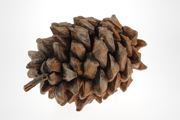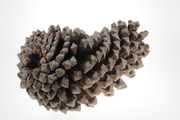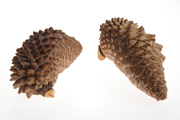
Martinez Pinyon pine cone
As Christmas approaches, we bring the outside in. Decorated pine trees are a festive essential, so we’ve invited our colleagues at the University of Oxford’s Herbaria to share a few of their favourites.
Pines belong to the genus Pinus, and have a prominent place in the plant kingdom. They grow in many places in the northern hemisphere, but are quite rare south of the Equator.
Of the approximately 170 pine species, the Scots Pine is the most widely distributed; occurring through Scotland, central Europe and Scandinavia, and extending into Russia and Mongolia.

Michoacan pine cone
Pines are long-lived evergreens. A Bristlecone Pine nicknamed ‘Prometheus’ was more than 4,844 years old when it was cut down in Nevada, USA in 1964. That means it must have germinated at the time of the early Ancient Egyptians! Pines can also reach great heights. The tallest, at 81.79 m, is a ponderosa pine growing in southern Oregon, USA.
The familiar woody pine cones are female reproductive structures and contain seeds. Most cones hang downwards while they grow; when the cone opens the winged seeds fall out and are dispersed by the wind. Pine seeds may also be dispersed by birds, typically when eaten by members of the crow family. The seeds germinate wherever they finally land, in the birds’ droppings.

Narrowcone pine cone
Different pines have adapted to specific habitats. Seeds of the narrowcone pine are only released after forest fires. They are protected in dense cones which do not burn. Once the fire has cleared the ground of competition from other plants, and produced plenty of nutrient-rich ash, conditions are right for the narrowcone pine seedlings to flourish.